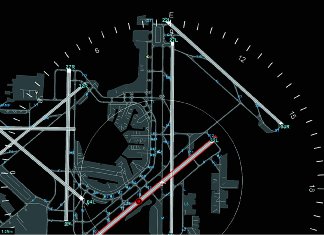 ACSS (E609) is moving ahead with the development of its SafeRoute system and is demonstrating the surface area movement management (SAMM) and Merging and Spacing (MAS) options at Dubai.
ACSS (E609) is moving ahead with the development of its SafeRoute system and is demonstrating the surface area movement management (SAMM) and Merging and Spacing (MAS) options at Dubai.
The new SafeRoute software suite, which uses ADS¬–B technology, will be certified by mid-2007. ACSS announced UPS as its launch customer at Paris.
ACSS president Kris Ganase says the software’s MAS option is capturing operators’ attention due to potential for fuel savings. At a typical commercial airport many of the aircraft arrive at the same time. This causes big headaches for air traffic controllers who have to juggle the demands of aircraft wanting to get on the ground with safety and other considerations.
The end result can be costly with aircraft being put into holding patterns.
SafeRoute’s MAS facility allows pilots to plan their route more carefully by showing what aircraft ahead are doing up to 100nm (185km) out. The pilot can then slow down or speed up to sequence or converge with them in a more efficient manner.
“In one study, UPS estimated that MAS could save them up to 880,000 gal (4 million litres) of fuel a year if MAS used 80% of the time,” says Ganase. “The FAA is also very keen on the system as it could reduce the workload on controllers and let aircraft fly closer together.”
UPS, the world’s largest package delivery company, operates 268 aircraft and will add Saferoute with the SAMM and MAS options to its aircraft.
Ganase also says that SafeRoute’s SAMM capability offers pilots an even better picture of what is happening around them when they are on the ground.
Runway
“The SAMM option not only shows a pilot where he is on a runway or taxiway, but where other aircraft are as well. It shows flightcrews their position on an airport surface map and by using other aircraft’s ADS-B transmissions, plus TIS-B and CDTI data, can display the position of other aircraft on the map as well,” he says.
Ganase adds: “SafeRoute can be added as an upgrade to our existing ACSS TCAS products, including T2CAS, TCAS 3000, or TCAS 2000, or it can be hosted within a competitor’s system as long it complies with the ARINC653 standard.
“There is currently no mandate for the compulsory use of products like this, but runway incursion accidents are the number one item on the NTSB’s safety agenda. As SafeRoute is software based and platform independent it makes good sense to add it to an existing TCAS system.”
Ganase adds that the SafeRoute SAMM option has cost-saving implications too. “If a pilot has a better picture of how many aircraft are taxiing and queuing to take off he can make a more informed decision as to whether he should start the engines or APU.”
STEVE NICHOLS
Source: Flight Daily News
















